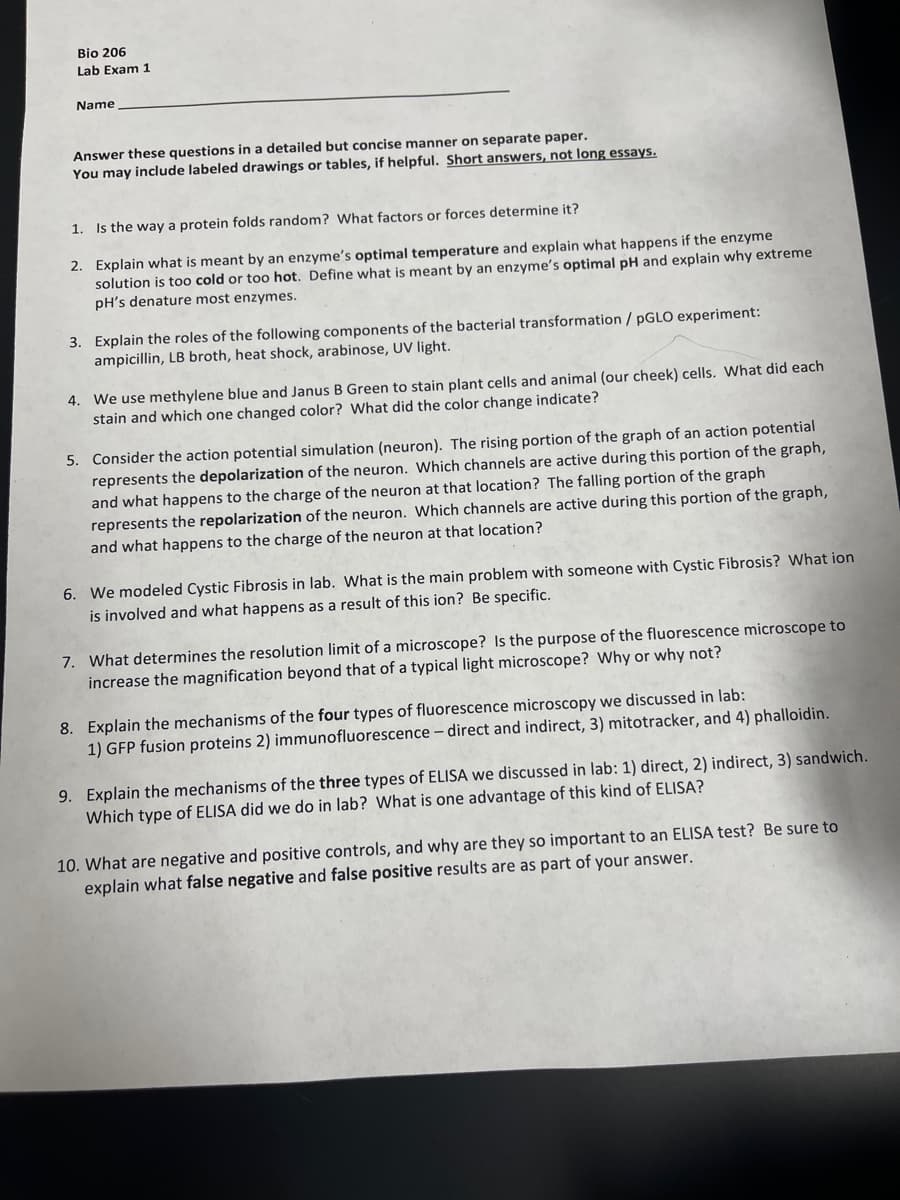Answer these questions in a You may include labeled drawings or tables, if helpful. Short answers, not long essays. 1. Is the way a protein folds random? What factors or forces determine it? 2. Explain what is meant by an enzyme's optimal temperature and explain what happens if the enzyme solution is too cold or too hot. Define what is meant by an enzyme's optimal pH and explain why extreme pH's denature most enzymes. 3. Explain the roles of the following components of the bacterial transformation/pGLO experiment: ampicillin, LB broth, heat shock, arabinose, UV light. ad animal four cheek) cells. What did each
Answer these questions in a You may include labeled drawings or tables, if helpful. Short answers, not long essays. 1. Is the way a protein folds random? What factors or forces determine it? 2. Explain what is meant by an enzyme's optimal temperature and explain what happens if the enzyme solution is too cold or too hot. Define what is meant by an enzyme's optimal pH and explain why extreme pH's denature most enzymes. 3. Explain the roles of the following components of the bacterial transformation/pGLO experiment: ampicillin, LB broth, heat shock, arabinose, UV light. ad animal four cheek) cells. What did each
Biology: The Dynamic Science (MindTap Course List)
4th Edition
ISBN:9781305389892
Author:Peter J. Russell, Paul E. Hertz, Beverly McMillan
Publisher:Peter J. Russell, Paul E. Hertz, Beverly McMillan
Chapter2: Life, Chemistry, And Water
Section: Chapter Questions
Problem 14TYK
Related questions
Question
Can someone help me please

Transcribed Image Text:Bio 206
Lab Exam 1
Name
Answer these questions in a detailed but concise manner on separate paper.
You may include labeled drawings or tables, if helpful. Short answers, not long essays.
1. Is the way a protein folds random? What factors or forces determine it?
2. Explain what is meant by an enzyme's optimal temperature and explain what happens if the enzyme
solution is too cold or too hot. Define what is meant by an enzyme's optimal pH and explain why extreme
pH's denature most enzymes.
3. Explain the roles of the following components of the bacterial transformation/pGLO experiment:
ampicillin, LB broth, heat shock, arabinose, UV light.
4. We use methylene blue and Janus B Green to stain plant cells and animal (our cheek) cells. What did each
stain and which one changed color? What did the color change indicate?
5. Consider the action potential simulation (neuron). The rising portion of the graph of an action potential
represents the depolarization of the neuron. Which channels are active during this portion of the graph,
and what happens to the charge of the neuron at that location? The falling portion of the graph
represents the repolarization of the neuron. Which channels are active during this portion of the graph,
and what happens to the charge of the neuron at that location?
6. We modeled Cystic Fibrosis in lab. What is the main problem with someone with Cystic Fibrosis? What ion
is involved and what happens as a result of this ion? Be specific.
7. What determines the resolution limit of a microscope? Is the purpose of the fluorescence microscope to
increase the magnification beyond that of a typical light microscope? Why or why not?
8. Explain the mechanisms of the four types of fluorescence microscopy we discussed in lab:
1) GFP fusion proteins 2) immunofluorescence - direct and indirect, 3) mitotracker, and 4) phalloidin.
9. Explain the mechanisms of the three types of ELISA we discussed in lab: 1) direct, 2) indirect, 3) sandwich.
Which type of ELISA did we do in lab? What is one advantage of this kind of ELISA?
10. What are negative and positive controls, and why are they so important to an ELISA test? Be sure to
explain what false negative and false positive results are as part of your answer.
Expert Solution
This question has been solved!
Explore an expertly crafted, step-by-step solution for a thorough understanding of key concepts.
Step by step
Solved in 2 steps

Knowledge Booster
Learn more about
Need a deep-dive on the concept behind this application? Look no further. Learn more about this topic, biology and related others by exploring similar questions and additional content below.Recommended textbooks for you

Biology: The Dynamic Science (MindTap Course List)
Biology
ISBN:
9781305389892
Author:
Peter J. Russell, Paul E. Hertz, Beverly McMillan
Publisher:
Cengage Learning

Biochemistry
Biochemistry
ISBN:
9781305961135
Author:
Mary K. Campbell, Shawn O. Farrell, Owen M. McDougal
Publisher:
Cengage Learning

Biology (MindTap Course List)
Biology
ISBN:
9781337392938
Author:
Eldra Solomon, Charles Martin, Diana W. Martin, Linda R. Berg
Publisher:
Cengage Learning

Biology: The Dynamic Science (MindTap Course List)
Biology
ISBN:
9781305389892
Author:
Peter J. Russell, Paul E. Hertz, Beverly McMillan
Publisher:
Cengage Learning

Biochemistry
Biochemistry
ISBN:
9781305961135
Author:
Mary K. Campbell, Shawn O. Farrell, Owen M. McDougal
Publisher:
Cengage Learning

Biology (MindTap Course List)
Biology
ISBN:
9781337392938
Author:
Eldra Solomon, Charles Martin, Diana W. Martin, Linda R. Berg
Publisher:
Cengage Learning

Biology 2e
Biology
ISBN:
9781947172517
Author:
Matthew Douglas, Jung Choi, Mary Ann Clark
Publisher:
OpenStax